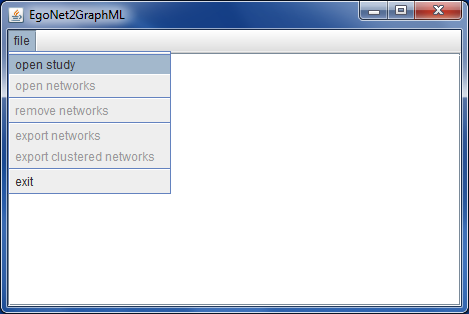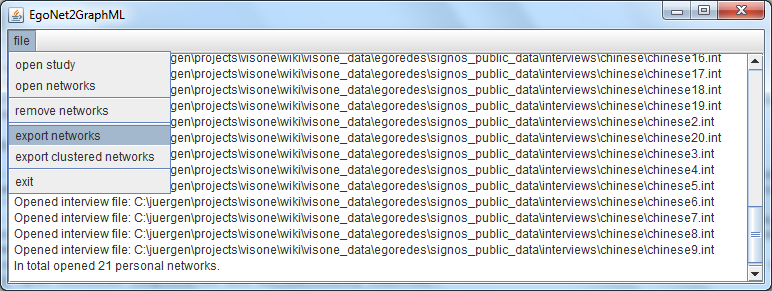Personal networks (tutorial): Difference between revisions
| Line 9: | Line 9: | ||
[[File:EgoNet2GraphML_open_study.png]] | [[File:EgoNet2GraphML_open_study.png]] | ||
To convert EgoNet interviews to GraphML you first have to open a study definition file | To convert EgoNet interviews to GraphML you first have to open a '''study definition file''' (filename extension <code>.ego</code>) and then one or more '''interview files''' (filename extension <code>.int</code>) that have been collected with the selected study definition file. Click on the '''open study''' menu item, select the file <code>signos.ego</code> in the previously downloaded <code>signos_public_data</code> (see above) and click on the '''open''' button. Then click on the '''open networks''' menu item, navigate to the directory <code>interviews/chinese</code> (for instance) and select the interview files to open. You may add the files one by one, or select several of them at once (by keeping the ''Control''-key down while selecting), or select all <code>.int</code> files in the current directory by typing ''Control-A''. You get short messages about each file you opened as well as the total number of currently open networks (duplicates are automatically removed). | ||
[[File:EgoNet2GraphML_export_networks.png]] | |||
To convert the interview files to GraphML click on the '''export networks''' menu item, select a directory to save the files (you might, for instance, create a new directory <code>graphml</code> as a subfolder of the <code>chinese</code> directory), and click the '''Export!''' button. EgoNet2GraphML exports all currently open networks to GraphML files; the filenames are the ones of the interview files - just with the extension <code>.int</code> replaced by <code>.graphml</code>. | |||
== Visual analysis of personal networks on the individual level == | == Visual analysis of personal networks on the individual level == | ||
Revision as of 09:04, 5 June 2012
EgoNet is a software to conduct interviews in which the personal networks of respondents are collected. This tutorial explains (1) how to load data collected with EgoNet into visone and (2) how to cluster, aggregate, and visualize collections of personal networks using the methodology proposed in: Ulrik Brandes, Juergen Lerner, Miranda J. Lubbers, Chris McCarty, and Jose Luis Molina "Visual Statistics for Collections of Clustered Graphs". Proc. IEEE Pacific Visualization Symp. (PacificVis'08), 2008 (link to pdf).
To follow the steps outlined in this tutorial you should download the Signos data and extract (unzip) the file on your computer. Furthermore you need the EgoNet2GraphML software to convert EgoNet interviews to GraphML files and apply the clustering and aggregation.
Converting EgoNet interviews into GraphML files
To open EgoNet interviews with visone you first have to convert these to GraphML with the EgoNet2GraphML software. When you have downloaded the file EgoNet2GraphML.jar from the EgoNet2GraphML website execute it (for instance by double-clicking). The main window opens as shown below.
To convert EgoNet interviews to GraphML you first have to open a study definition file (filename extension .ego) and then one or more interview files (filename extension .int) that have been collected with the selected study definition file. Click on the open study menu item, select the file signos.ego in the previously downloaded signos_public_data (see above) and click on the open button. Then click on the open networks menu item, navigate to the directory interviews/chinese (for instance) and select the interview files to open. You may add the files one by one, or select several of them at once (by keeping the Control-key down while selecting), or select all .int files in the current directory by typing Control-A. You get short messages about each file you opened as well as the total number of currently open networks (duplicates are automatically removed).
To convert the interview files to GraphML click on the export networks menu item, select a directory to save the files (you might, for instance, create a new directory graphml as a subfolder of the chinese directory), and click the Export! button. EgoNet2GraphML exports all currently open networks to GraphML files; the filenames are the ones of the interview files - just with the extension .int replaced by .graphml.

